At the foot of Sierra Nevada, between the rivers Darro and Genil, lies one of the most interesting cities in Eastern Andalusia. The impressive Andalusian legacy is added to Renaissance architectural jewels and the most modern facilities of the 21st century.
The fact that Granada is the last city reconquered by the Catholic Monarchs in 1492 gives it an unmistakable Arabic aroma. Its gastronomy, craftsmanship and town planning are determined by its glorious historical past. Fountains, viewpoints and Carmenes, the houses surrounded by characteristic gardens of this city, contribute to create unforgettable corners. Not in vain, one of its old neighborhoods, the Albaicín, is a World Heritage Site along with La Alhambra y el Generalife. An important cultural centre for many centuries, both during the Muslim and Christian rule, it now enjoys an enviable cultural and leisure agenda. Film, music and theatre festivals and seasons are complemented by permanent and travelling exhibitions covering all fields of knowledge. Former Renaissance palaces host seminars, conferences and colloquia, while the most innovative infrastructures are prepared for major events.
Its good communications, together with its wonderful climate and abundant proposals of beaches and snow make Granada a unique destination for cultural, adventure and congress trips...
The last kingdom to be reconquered by the Catholic Monarchs has an incredible historical-artistic heritage. Arab and Christian elements shake hands in the streets of Granada. The palace complexes of La Alhambra y el Generalife, along with the Albaicín district, have been declared a World Heritage Site by UNESCO. The Gran Vía de Colón and the Avenida de los Reyes Católicos will lead visitors to the most important neighborhoods and monuments erected in the Renaissance.
The Tapas
Although perhaps not the most outstanding feature of local cooking, the tapas served free in all the province's bars to wash down with a glass of wine or a beer are a tasty symbol of Granada, stimulating the senses and get immediately carved in the visitors memory. As miniature cooking, tapas are the most informal yet varied and tasty way to have lunch or dinner out. Kitchens delight their customers tastebuds with little plates ofstewed snails, Andalusia style potatoes, fish in batter and offal in sauce to name but a few, in more or less hearty portions.
Some authors assert that the tapa was born when, due to an illness, the Spanish King Alfonso The 10th., "The Wise", had to take small bites of food with some wine between meals. Once recovered from the disease, the wise king decreed that no wine was to be served in any of the inns in the land of Castile, unless accompanied by something to eat. This was a wise precaution to counteract the adverse effects of alcohol on those people who, through lack of money to buy a nourishing meal, drank alcohol on an empty stomach.
A little history of tapas
It is said that it was King Alfonso X "The Wise" who ordered that wine should not be served in the inns of his kingdom unless accompanied by some food. This prevented the wine from rising quickly to the head.
The lid, at first, was placed over the mouth of the jug or glass served, so the container was "covered": hence the origin of the word. It was used to accompany the drink and to prevent any "flying visitor" from entering the precious liquid. In those days the lid consisted of a slice of ham or slices of chorizo or other sausage and was sometimes replaced by a wedge of cheese.
Monuments in Granada
- Alhambra y Generalife
- Albaicín de Granada
- Catedral de Granada
- Capilla Real
- Monasterio de la Cartuja
- Abadía del Sacromonte
- Monasterio de San Jerónimo
- Hospital Real
- El Bañuelo
- Casa Castril - Museo Arqueológico
- Carmen de los Mártires
- Corral del Carbón
- Casa del Chapiz
- San Juan de Dios
- Iglesia de Santo Domingo
- Casa de Zafra
- Horno de Oro
- Rodríguez-Acosta
Alhambra y Generalife
Parts and places in the Alhambra and Generalife
The Alhambra complex is more than just a palace, it is a whole walled citadel within the city of Granada. It has royal apartments, fortresses, gardens, pavilions, barracks, etc... all surrounded by an impressive wall.
Los Palacios Nazaríes
They are a group of small palaces with a series of structures surrounding them that were born out of a purely transitory and ornamental need. Since the 16th century, these Nazarite fortresses have been designated the Old Royal House to distinguish them from Christian buildings.
El Palacio de Carlos V
It is one of the emperor's projects for the city of Granada.
The choice of the Alhambra for its construction shows the king's sensitivity to the beauty of Arab palaces, and his interest in preserving them for history.
La Alcazaba
The Alcazaba is, together with Torres Bermejas, the oldest part of the Alhambra. It is thought that before its construction and the arrival of the Muslims to Granada there were several buildings in the same area. The first news we have of the existence of the Alcazaba in Granada dates from the 9th century, when it was supposedly built by Sawwar ben Hamdun during the struggle between the Arabs and the Muladies.
La Medina
A whole city designed to cover any need of the Palace. Organized around a main street that rises gently from west to east, the city was equipped with public baths, a mosque, shops, etc.
Cementerio Real
The privileged garden where the remains of the Granadine princes rested is visited just as you leave the Nasrid Palaces, standing between them and that of Charles V. The garden has been recently restored, adapting it to the visit and highlighting its original structure.
Jardines y Palacio del Generalife
Recreational house of the Sultans of Granada, surrounded by orchards and gardens, the latter recently created, along with the amphitheatre at the entrance, which hosts some of the performances of the Music and Dance Festival every year.
Albaicín de Granada
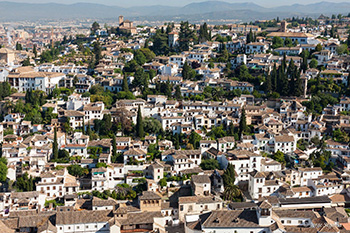
Old Muslim quarter of Granada. Origin of the modern Granada, under the Iberian and later Roman domination, the Albayzín, owes its physiognomy to the Arab period during which it became the residence of kings and court of the kingdom, both with the Zirí emirate and, sometimes, during the Nasrid period. It has been catalogued as a World Cultural Heritage Site since 1989 by UNESCO and is, as a whole, a monument.
Catedral de Granada
The first Renaissance Cathedral in Spain, and the second largest Cathedral in the country. Projected in the heart of Granada, it was to show the world the importance of the city and the important moment it was experiencing. Of extraordinary dimensions, the Cathedral of Granada shows a very interesting and completely rounded High Altar without precedents in the history of architecture and the most interesting collection of works by the important artist from Granada and Andalusia, Alonso Cano.

Capilla Real
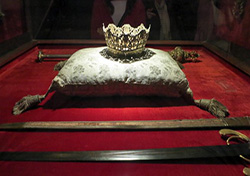
The Royal Chapel of Granada houses the mortal remains of Ferdinand of Aragon and Isabella of Castile, Joan I and Philip I and Prince Michael. After the conquest of Granada (1492), the Catholic Kings decided to build their own sepulchral chapel inside the Cathedral of Granada. In the place where the Great Mosque used to be, there are currently four buildings: the Cathedral, the Royal Chapel, the Lonja and the Sagrario Church.
The design of the Royal Chapel began in 1504 and was drawn up by Enrique Egas (1505-1517) following the wishes of the Catholic Queen for austerity.
Monasterio de la Cartuja
The Monastery of Nuestra Señora de la Asunción, better known as La Cartuja de Granada is a monastery located in Granada that housed a community of Carthusian monks from its construction until 1835. Although it mixes different styles, it represents one of the peaks of Spanish baroque architecture.
It arose from the decision taken in 1458 by the community of the monastery of Santa María de El Paular and construction began in 1506 once its location was established, following the transfer of some land by the Grand Captain, Gonzalo Fernández de Córdoba. In 1516, work was restarted which would last three centuries without completing the initial project, of which only part remains, because in 1842 the cloister and the monks' cells were destroyed, affecting the priory house which was totally destroyed in 1943. It was inhabited until 1835 when the monks were expelled from it.
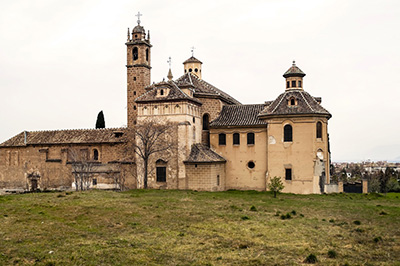
Abadía del Sacromonte
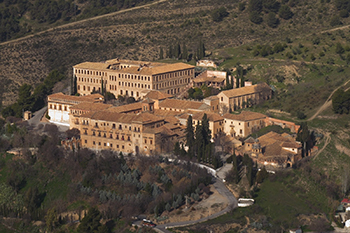
The Sacromonte Abbey, founded in the 17th century. Under the church are the catacombs, where San Cecilio, the first bishop and today the patron saint of Granada, suffered martyrdom. The most notable features of this temple, next to the Darro, designed by Juan de Maeda and finished in 1567, are the extraordinary Mudejar coffered ceilings of the central nave, the transept and the main chapel, as well as the Renaissance roof of the first of the ten chapels, all of which were built by Juan Vílchez. The cover, by Pedro de Orea, is a magnificent example of the Andalusian Renaissance of the end of the 16th century.
From the abbey it is called the Sacromonte Valley. It is situated on the summit of Mount Valparaíso at the end of the seven-slope path. The path, which has wonderful views of the Hazelnut fountain, has four of the monumental crosses left, thousands of which were placed on this Ilipulitan mountain during the 17th century by the various guilds, families and people devoted to these "holy places". From this place you can see a beautiful panorama: The Alhambra, the Christian city, the Albayzin, Jesus del Valle... The access can be done either by the Camino del Sacromonte, which starts at the Peso de la Harina located in the middle of the Cuesta del Chapiz, or by the Camino de San Antonio starting from Haza Grande. The current legislation - Spanish and Andalusian Historical Heritage Law - grants it the status of Cultural Interest Property (B.I.C.), which entails the highest level of protection.
Monasterio de San Jerónimo
The Monastery of San Jerónimo, is a Renaissance architectural work formed by a church and a monastery located in Granada, Spain.
Its foundation, before the capture of the city, is due to the Catholic Kings. It was soon moved from Santa Fe to Granada, and it was in 1504 when construction began on the current complex. The work is mostly due to Diego de Siloé, although other architects and artists participated in its construction, such as Jacobo Florentino, Juan de Aragón, Juan Bautista Vázquez el Mozo, Pedro de Orea and Pablo de Rojas, the last three from the Granada school.
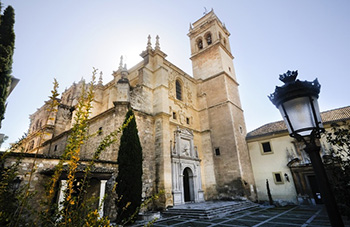
Hospital Real
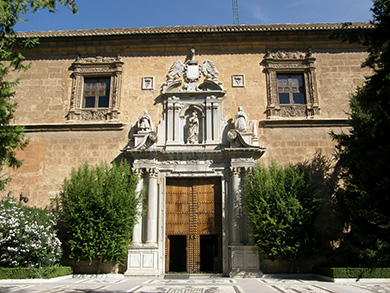
The Royal Hospital was founded by the Catholic Monarchs in 1504 to care for the wounded from the War of Granada. Construction began according to the plans of Enrique Egas, within the final Gothic, but it was Charles V who was responsible for its completion in the Renaissance style. The cover was not completed until the first half of the 17th century. Today the building is the headquarters of the University of Granada, where the Rectorate and other university services are located, such as the Central Library of the University.
It is located between the streets Real de Cartuja, Ancha de Capuchinos and Avenida del Hospicio, where its entrance is located. In this place there was a cemetery in Muslim times (Saad Malik) and with the Christian conquest the land was given to the city as an ejido - common land for a municipality.
El Bañuelo
Ancient Arab baths, built in the 11th century. In them we can contemplate the typical distribution of this type of buildings, similar to that of the Roman baths, with three rooms in which the temperature was progressively increasing.
Skylight vaults are also common, which here are octagonal and star-shaped. On the columns we can see Roman, Visigoth and Caliphal capitals. In the last room we can see pipes that took the hot water under the floor, to heat the rooms.
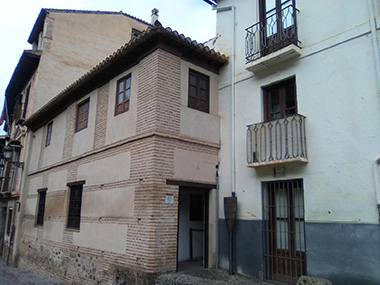
Casa Castril - Museo Arqueológico
The so-called Casa de Castril by the Señorio de Castril of the descendants of Hernando de Zafra, to whom the house belonged, is one of the most beautiful Granada palaces of the Renaissance.
The Catholic Kings granted their personal secretary, Don Hernando de Zafra, the lordship of Castril, a title inherited by his family. One of his grandchildren built this palatial house in the Albaicín neighbourhood in 1539, with its beautiful sandstone plateresque façade standing out. It has a central balcony with medallions in relief and a frieze with the figure of an angel accompanied by taps. The building is structured around a quadrangular courtyard, formed by porticoes with semicircular arches supported by marble columns. The staircase leading to the second floor is covered with a sensational Mudejar coffered ceiling. At present it is the headquarters of the Provincial Archaeological Museum.
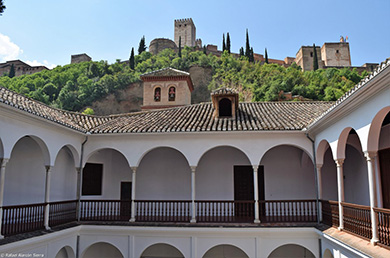
Carmen de los Mártires
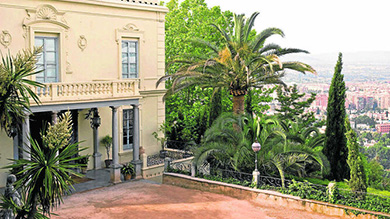
According to tradition, the Carmen de los Mártires is built over the ancient dungeons of the Christian captives in Nazarite times. Once the city was conquered by the Catholic Kings it became a Carmelite convent where San Juan de la Cruz was prior for some years. Its current appearance corresponds to the 19th century, and the orientalist tendencies of the time can be appreciated. The gardens are a successful mix of French and English models together with the aesthetics of the Andalusian gardens.
Called "Ahabul's field" by the Arabs, the Carmen of the Martyrs was the place from which Boabdil left to hand over his beloved city to the Christians. Isabel the Catholic built a chapel on the site as a souvenir of that day. Later a convent was built and, on its ruins, a small palace. In its surroundings, a garden.
Constructions and green spaces that contain the vicissitudes of a place with several centuries of history, where the garden that surrounds and embellishes it reaches our days with an extensive mix of events embedded in its layout. Pieces of history, splendour and ruin, an ordered chaos. Garden, orchard, island, lake, courtyard, a garden of gardens.
Carmen de los Martires is located on the hill of the Alhambra. A magnificent palace, romantic gardens and Nazari orchards overlooking the city of Granada.
Corral del Carbón
The original name of the Corral del Carbón was Alhóndiga Gigida, it was built at the beginning of the 14th century and was used as a merchandise store and a merchant's hostel. It is of special interest because it is the only building of this type preserved entirely in Spain.
In Christian times it was used as a hostel for charcoal makers, hence its name; later it became a comedy barnyard and finally a tenement house, until in 1933 it was acquired by the State and restored by the architect Leopoldo Torres Balbás.
The building has a quadrangular floor plan, with an entrance pavilion with a large horseshoe arch, which leads to the hall, with a beautiful muqarnas dome. Above the entrance door there is a small twin window. From here we access the entrance hall, with arches on its sides, from which we enter the courtyard of the building, surrounded by galleries that open on all three floors of the building. In the centre we see a stone fountain with two spouts.
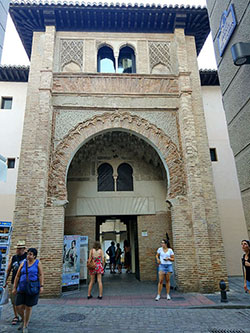
Casa del Chapiz
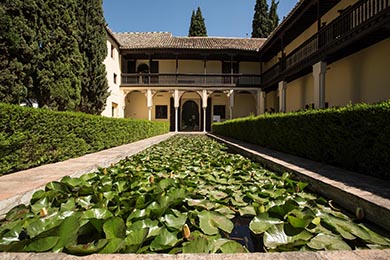
Las Casas del Chapiz, constitute two interesting examples of Hispanic-Muslim domestic architecture, which motivated its declaration as a National Monument by Royal Order on December 3, 1919.
Once they have been restored with the great skill that was customary in Mr Leopoldo Torres Balbás, and used for such an appropriate purpose as to serve as the headquarters of the School of Arab Studies, their conservation is guaranteed for the enjoyment of all those who wish to admire how the exceptional values of the palace architecture of the Alhambra also extended, although in a more modest way and on a smaller scale, to many of the homes of Granada's Muslims.
San Juan de Dios
In the middle of the 18th century the Basilica of San Juan de Dios was built, which is located in the street of the same name, in Granada.
It is a real jewel of baroque art, which Fray Alonso de Jesús y Ortega ordered to be built.
Among the valuable elements are gold and silver ornaments, magnificent murals and altarpieces, lights and cornucopias. The altarpieces are of great beauty, especially that of the main altar, where the remains of Saint John of God rest in a dressing room, inside a silver urn.

Iglesia de Santo Domingo
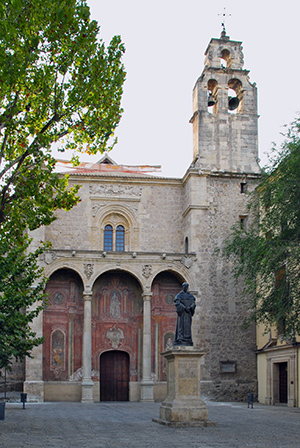
Entrance to the Church of Santo Domingo located in a square, in the typical Granada neighbourhood of Realejo, in the centre of which there is a sculpture by Fray Luis de Granada.
It began to be built in 1512, it was part of the Monastery of Santa Cruz, it follows the gothic forms typical of the Granada of this period, the ogival taste can be seen in its arches and vaults, we do not know who was the tracist and director of the work.
Completed in the Renaissance, Baroque and Contemporary periods by various artists who make it one of the most important buildings in Granada.
Casa de Zafra
The Arab house of Zafra, located in the Albaicin quarter declared World Heritage in 1994, is one of the most relevant and best preserved examples of Andalusian residential architecture. The cultural values of the property that has come to us are numerous. In it, we find historical, artistic, architectural and landscape values of the first order.
It was originally integrated into the urban space that made up the Andalusian Granada complex, specifically in the so-called Axares (del Deleite) neighbourhood, which must have been one of the most important noble neighbourhoods in Hispano-Muslim Granada. This building is an architectural example that has maintained its eminently Nazarite character despite the various transformations it has undergone over time.
The architecture of this building, which dates back to the 14th century and was extended in the 15th century, perfectly represents the type of Nasrid house organised around a rectangular courtyard, with a central pool, and a north-south longitudinal axis marked by the presence of porticoes facing each other on these smaller sides that precede the noble rooms of the house.
Its entrance is through a corner hallway to avoid direct vision from the outside and to safeguard the domestic privacy that gives access to the courtyard, which becomes the element that distributes the different rooms of the house.
Among the original artistic elements that have been preserved are columns, capitals, scalloped arches, angrelados and gallonados, albanegas decorated with rosettes and stars of eight, atauriques, marble flooring, right feet with shoes, armor and pottery with traces of polychrome among others, highlights the presence of the remains of wall paintings Nazari, which gives it a uniqueness that has no other houses of Muslim character preserved in Granada. They are located in the southern wing of the house and correspond to the same typology as those exhibited in some rooms of the Alhambra.
The excellent state of conservation that the house has acquired after its restoration allows the visitor to clearly perceive the physiognomy of the traditional noble houses of the Nasrid era.
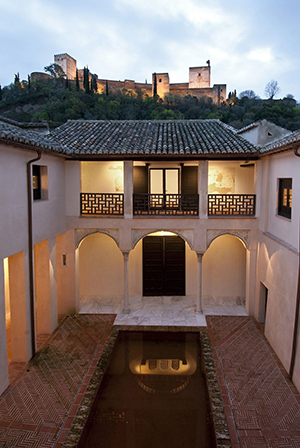
Horno de Oro
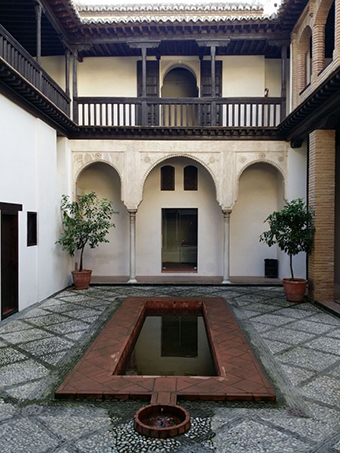
The Casa Horno de Oro is located in the district of Axares - de la Salud o del Deleite, so called in the Muslim era because of its good weather conditions and the beauty of its houses. Built at the end of the 15th century, the transformations of the 16th century made it an interesting example of a Moorish house that integrates Islamic and Castilian elements. The simplicity of its façade does not allow us to imagine the architectural harmony it hides inside. A rectangular courtyard with a swimming pool centres the building, with the rooms on the smaller sides. The arches in the courtyard, in the Nasrid tradition, support a porticoed gallery built in the Christian era. The southern room on the upper floor preserves the original plasterwork arch at the entrance, and the tiles on the jambs, as well as the splendid polychrome wooden framework that covers it.
Rodríguez-Acosta
On the hill where the Alhambra is located and a few meters from it, is located the Carmen of the Rodriguez-Acosta Foundation, one of the most unique buildings of its kind in Spain. Built in the first decades of the 20th century, it was declared a National Monument in 1982. The place was the studio of the prestigious painter José María Rodríguez-Acosta and houses a unique set of gardens and a large collection of pieces, from ancient art to modernist, in a surprising tour of the building that includes old caves and underground galleries.
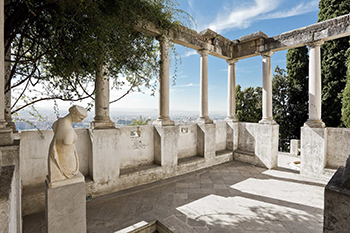
Hotels in Granada
Opinions
Recorrimos Granada aprendiendo sobre la apasionante historia; monumentos y las mejores vistas. Amelia sin dudas la mejor guía!! Excelente predisposición, muy clara en todo momento, muy recomendable.
Free Tour Granada
Estupendo guía, David, nos hizo disfrutas de los alrededores de la alhambra a mis 9 amigas y a mí, gracias por esas magnificas explicaciones. Súper recomendable.
Free Tour Granada
Muy recomendado. Nuestra guía Amelia nos hizo el recorrido muy ameno, con una gracia y sonrisa a cada momento. Una explicación de diez. Nos dio a conocer unos rincones preciosos con unas vistas estupendas. Y al acabar una recomendaciones de lugares donde comer y tomar algo que nos ayudó muchísimo. 100% recomendado.
Free Tour Granada




